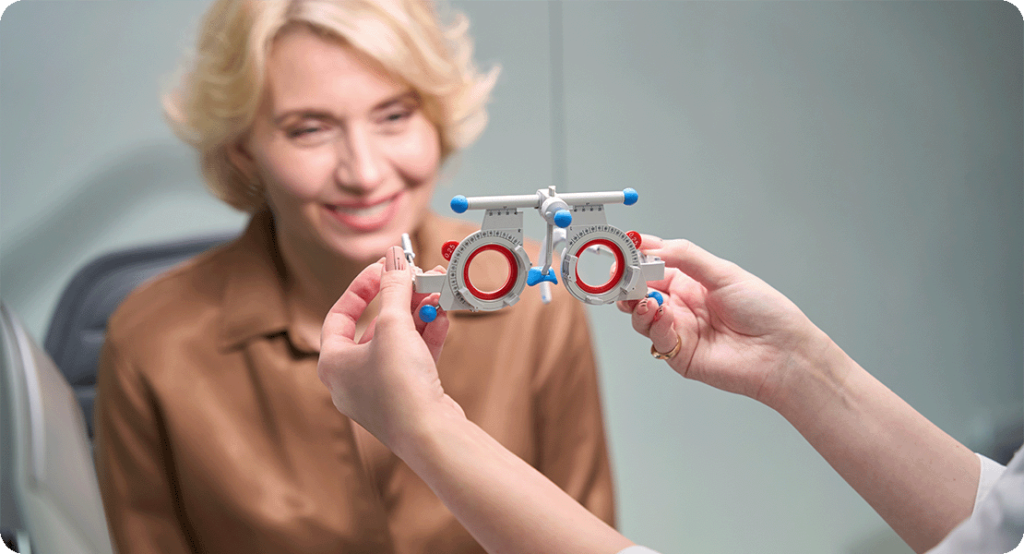Cataract surgery is one of the most common and successful procedures in modern medicine, restoring vision for millions of people worldwide. It involves removing the eye’s cloudy natural lens and replacing it with an artificial intraocular lens (IOL). While many patients experience significantly improved vision, some still require glasses after surgery. This can be due to several factors, including the type of IOL used, pre-existing eye conditions, and individual variations in healing.
1. Types of Intraocular Lenses (IOLs) Used
The type of intraocular lens (IOL) implanted during cataract surgery is one of the most significant factors in determining whether a patient will still need glasses afterward. Each type of IOL has specific characteristics that influence how well it corrects vision, and not all lenses provide complete freedom from spectacles. Understanding these different options helps patients make informed choices based on their visual needs and lifestyle preferences.
Monofocal IOLs – Clear Vision at a Single Distance
Monofocal IOLs are the most commonly used lenses in cataract surgery. They are designed to focus light at one fixed distance—either near, intermediate, or far. While they provide excellent clarity at the chosen focal length, they do not adjust for different distances, meaning patients will still need glasses for certain activities.
- Distance Monofocal IOLs – If the lens is set for distance vision, the patient will see far objects clearly but will need reading glasses for near tasks like reading or using a smartphone.
- Near Monofocal IOLs – If the lens is set for near vision, patients can read without glasses but will require corrective lenses for driving or watching television.
- Intermediate Monofocal IOLs – Some people opt for an intermediate focal point, which is useful for computer work or dashboard viewing while driving, but they will still need glasses for both near and far vision.
Many patients who receive monofocal lenses choose monovision, where one eye is corrected for distance vision and the other for near vision. While this can reduce dependence on glasses, it may take time for the brain to adapt, and some people experience difficulty with depth perception.
Multifocal IOLs – Vision at Multiple Distances
Multifocal IOLs are designed to correct vision at multiple distances, significantly reducing or even eliminating the need for glasses. These lenses have different zones that allow the eye to focus on near, intermediate, and distant objects.
However, there are some drawbacks:
- Halos and Glare – Some patients experience glare or halos around lights, particularly at night, which can make driving in low-light conditions challenging.
- Contrast Sensitivity Reduction – These lenses may slightly reduce contrast sensitivity, making it harder to see in dim lighting or distinguish between similar colours.
- Adaptation Period – The brain must learn to adjust to the way these lenses split incoming light, which can take a few weeks or even months. Some people adapt well, while others struggle with the adjustment.
For those who prioritise reducing dependence on glasses and are willing to adapt to the visual trade-offs, multifocal IOLs can be an excellent option. However, they may not be suitable for individuals with certain eye conditions such as severe astigmatism or macular degeneration.

Toric IOLs – Correction for Astigmatism
Toric IOLs are specifically designed for patients who have astigmatism, a condition where the cornea or lens has an irregular shape, causing blurred or distorted vision. Unlike standard IOLs, toric lenses include additional corrective power to compensate for these irregularities.
While toric IOLs can significantly reduce astigmatism, some patients may still need glasses for fine-tuning their vision, particularly if they have residual refractive errors or if the IOL rotates slightly out of alignment post-surgery. Additionally, not all levels of astigmatism can be fully corrected with toric IOLs alone, and some individuals may require additional procedures like limbal relaxing incisions (LRIs) or laser correction for optimal results.
Extended Depth of Focus (EDOF) IOLs – A Middle Ground
Extended Depth of Focus (EDOF) IOLs are a newer option that provide a continuous range of vision, rather than distinct focal points like multifocal lenses. These lenses extend the range of focus, allowing for improved intermediate vision while still offering some level of near and distance clarity.
- Less Glare and Halos – Compared to multifocal lenses, EDOF IOLs generally cause fewer night vision issues.
- Great for Intermediate Tasks – They are particularly beneficial for activities such as working on a computer, using tablets, or playing musical instruments.
- Mild Near Vision Limitations – While they offer better range than monofocal IOLs, most patients will still require reading glasses for very close tasks, like reading fine print.
Accommodating IOLs – Mimicking the Natural Lens
Accommodating IOLs are designed to move slightly within the eye, mimicking the natural focusing ability of the human lens. They work by shifting forward and backward in response to the eye’s focusing effort, providing a greater range of vision. However, the effectiveness of accommodating IOLs can vary from person to person, and some patients may still need reading glasses.
Choosing the Right IOL for Your Needs
Selecting the right IOL depends on several factors, including:
- Lifestyle – People who spend a lot of time reading may prefer multifocal lenses, while those who drive frequently at night may benefit from monofocal or EDOF IOLs.
- Budget – Premium IOLs like multifocal, toric, and EDOF lenses typically cost more than standard monofocal IOLs.
- Tolerance for Visual Side Effects – Some individuals are more sensitive to halos, glare, or reduced contrast sensitivity, which can affect the choice of lens.
- Pre-existing Eye Conditions – Conditions like glaucoma, macular degeneration, or diabetic retinopathy may influence which IOL is suitable.

2. Pre-Existing Eye Conditions
Cataract surgery is highly effective at restoring vision by replacing the cloudy natural lens with a clear artificial one. However, many patients have additional eye conditions that can affect the outcome of the surgery. These pre-existing conditions may prevent full visual correction, meaning that glasses or further treatments might still be necessary for optimal vision.
Here are some of the most common pre-existing conditions that can impact visual outcomes after cataract surgery:
Astigmatism – Blurred or Distorted Vision
Astigmatism occurs when the cornea or the natural lens has an uneven curvature, causing light to focus at multiple points rather than a single sharp image on the retina. This results in blurred or distorted vision at all distances.
- Mild to Moderate Astigmatism – For lower levels of astigmatism, standard IOLs may not provide sufficient correction, meaning that glasses will still be needed after surgery for clearer vision.
- Severe Astigmatism – In cases of high astigmatism, patients may require a toric IOL, which is specifically designed to counteract the irregular shape of the cornea. However, even with toric lenses, some residual astigmatism may persist, necessitating the use of glasses for certain tasks.
- Surgical Solutions – Additional procedures like limbal relaxing incisions (LRIs) or laser vision correction (LASIK, PRK) may be necessary to fully correct astigmatism after cataract surgery.
Presbyopia – The Natural Aging of the Eye
Presbyopia is an age-related condition that reduces the eye’s ability to focus on close objects. It typically begins in the mid-40s and progresses over time. While cataract surgery removes the cloudy lens, it does not reverse the effects of presbyopia unless a specialised IOL is implanted.
- Monofocal IOL Limitation – Patients who receive a standard monofocal IOL will still need reading glasses, as these lenses only focus at a single distance.
- Multifocal and EDOF IOLs – To reduce dependence on reading glasses, patients can opt for a multifocal IOL or an extended depth of focus (EDOF) IOL, which provide a broader range of vision. However, these lenses may come with trade-offs such as halos or reduced contrast sensitivity.
- Monovision Option – Another alternative is monovision, where one eye is corrected for near vision and the other for distance vision. While this can reduce the need for reading glasses, it may take time for the brain to adapt, and some individuals may struggle with depth perception.

Macular Degeneration – A Limitation on Visual Potential
Age-related macular degeneration (AMD) is a progressive disease that affects the macula, the central part of the retina responsible for sharp vision. This condition can significantly impact the quality of vision after cataract surgery, even if the surgery itself is performed successfully.
- Dry AMD – This is the more common form of macular degeneration, causing gradual deterioration of central vision over time. While cataract surgery can improve clarity, it cannot restore central vision lost due to AMD.
- Wet AMD – This more severe form of AMD is characterised by abnormal blood vessel growth in the retina, leading to sudden vision loss. Patients with wet AMD may have limited improvement from cataract surgery and often require ongoing treatments, such as anti-VEGF injections, to manage the condition.
- Managing Expectations – Patients with AMD should have realistic expectations about their post-surgery vision, as cataract removal will not reverse macular damage. Glasses or magnifying devices may still be necessary for reading and Diabetic Retinopathy – A Challenge to Visual Recovery
Diabetic retinopathy is a complication of diabetes that affects the blood vessels in the retina. It can cause vision loss due to bleeding, swelling, or scarring of the retina. Cataract surgery may improve vision in these patients, but the extent of improvement depends on the severity of the underlying retinal damage.
- Mild Diabetic Retinopathy – Patients with early-stage diabetic eye disease may still benefit significantly from cataract surgery, but they may experience slower recovery times.
- Advanced Diabetic Retinopathy – In severe cases, where there is significant retinal damage, cataract removal may not provide the expected clarity. These patients may still require glasses or additional treatments like laser therapy or anti-VEGF injections to stabilise their vision.

Glaucoma – Increased Risk of Vision Loss
Glaucoma is a condition that damages the optic nerve, often due to high intraocular pressure. Cataract surgery can sometimes help lower eye pressure, but it does not reverse existing optic nerve damage.
- Glaucoma and Cataract Surgery Risks – Some glaucoma patients have a higher risk of complications during and after cataract surgery, particularly those with advanced optic nerve damage.
- Visual Limitations – If a patient has significant glaucoma-related vision loss, cataract surgery will not restore the lost peripheral vision, and glasses may still be needed for the best possible clarity.
- Combined Procedures – In some cases, minimally invasive glaucoma surgery (MIGS) can be performed alongside cataract surgery to help manage eye pressure more effectively.
Other Pre-Existing Conditions That May Affect Cataract Surgery Outcomes
- Corneal Diseases – Conditions like keratoconus or Fuchs’ dystrophy can cause irregular corneal shape or swelling, which may affect the final vision outcome. Some patients may still need glasses or contact lenses for optimal correction.
- Retinal Conditions – Diseases such as retinitis pigmentosa, epiretinal membranes, or retinal detachment can interfere with visual improvement after cataract surgery.
- Lazy Eye (Amblyopia) – If a patient has amblyopia from childhood, their brain may never have developed full visual processing in one eye, meaning that cataract surgery will not improve that eye’s vision beyond its pre-existing limits.
3. Residual Refractive Errors
Cataract surgery is designed to restore clear vision by replacing the eye’s cloudy natural lens with an artificial intraocular lens (IOL). However, despite advanced surgical techniques and precise pre-operative measurements, residual refractive errors can still occur. These are small imperfections in the way light is focused onto the retina, which can result in slightly blurry vision, glare, or the continued need for glasses in some situations.
Residual refractive errors can be caused by a range of factors, including biological variations, surgical precision, and the type of IOL implanted. Below are some of the most common reasons why some patients do not achieve perfect vision after cataract surgery.
Mild Nearsightedness (Myopia) or Farsightedness (Hyperopia)
Even with state-of-the-art pre-operative calculations, it is not always possible to achieve perfect focus after cataract surgery. Small deviations can result in mild nearsightedness or farsightedness, which may require glasses for fine-tuning vision.
- Nearsightedness (Myopia) – If the implanted IOL has slightly too much focusing power, distant objects may still appear somewhat blurry, while near vision remains relatively clear.
- Farsightedness (Hyperopia) – If the IOL has slightly too little focusing power, near objects will be difficult to see clearly, and reading glasses may still be needed.
The degree of residual error varies from patient to patient. For some, it is barely noticeable, while others may find it bothersome, particularly when performing tasks like reading or driving. Minor residual refractive errors can often be corrected with glasses, contact lenses, or additional procedures.
Small Astigmatism – Blurred or Distorted Vision
Astigmatism occurs when the cornea or lens is shaped more like a rugby ball rather than a perfect sphere, causing light to focus unevenly on the retina. While toric IOLs and other corrective techniques can significantly reduce astigmatism during cataract surgery, some level of residual astigmatism may remain, leading to blurred or distorted vision at certain distances.

Causes of Residual Astigmatism After Cataract Surgery
- Under-correction or Over-correction – The degree of astigmatism may not be fully corrected, leaving some residual blurriness.
- IOL Rotation – Toric IOLs must be precisely positioned to correct astigmatism. If the lens rotates slightly after surgery, it may lose some of its corrective power.
- Corneal Irregularities – If a patient has an irregularly shaped cornea (e.g., keratoconus or scarring from previous surgeries), an IOL alone may not fully correct vision.
Even a small amount of astigmatism can result in noticeable visual distortions, especially in low-light conditions. Some patients may need glasses with astigmatic correction for certain tasks, or laser vision correction (LASIK/PRK) if they wish to be completely free from glasses.
Surgical Variability – How Healing Can Affect Final Vision
Every eye heals differently after surgery, and even minor variations in healing can affect the final refractive outcome. While modern surgical techniques are highly precise, certain biological factors can cause unexpected visual results.
Factors That Can Influence Healing and Refractive Outcomes:
- Individual Healing Response – Some patients experience slightly more swelling or scarring, which can subtly alter how light is focused in the eye.
- Corneal Shape Changes – The cornea can undergo small shifts in shape after surgery, leading to mild refractive changes over time.
- IOL Positioning – The final position of the intraocular lens inside the eye is crucial. Even a tiny shift in its placement can affect its focusing power.
- Pre-existing Corneal Conditions – Patients with conditions such as dry eye syndrome or previous corneal surgeries may have an unpredictable healing response, impacting visual sharpness.
While some of these factors settle naturally over time, others may require glasses, contact lenses, or further interventions to achieve the best vision.
Other Causes of Residual Refractive Errors
While myopia, hyperopia, and astigmatism are the most common refractive issues after cataract surgery, other factors may also contribute to suboptimal vision:
Posterior Capsule Opacification (PCO) – “After-Cataract” Blurring
- Over time, some patients develop posterior capsule opacification (PCO), a condition where the thin membrane left behind to support the IOL becomes cloudy, mimicking cataract-like symptoms.
- PCO is easily treated with a quick and painless YAG laser capsulotomy, which restores clarity by creating an opening in the cloudy capsule.
Glare and Halos from Multifocal IOLs
- Some patients with multifocal or extended depth of focus (EDOF) IOLs may experience glare, halos, or reduced contrast sensitivity, particularly in low-light conditions.
- While the brain can adapt to these changes over time, some individuals may find glasses or additional procedures helpful for improving night vision.
Residual Prescription from Pre-Surgery Conditions
- If a patient had a strong glasses prescription before cataract surgery, there may still be a mild residual need for correction afterward.
- Some people who have had previous refractive surgery (like LASIK) may experience unexpected refractive shifts due to the altered shape of their cornea.
Treatment Options for Residual Refractive Errors
For patients who experience noticeable refractive errors after cataract surgery, there are several options available to fine-tune vision:
- Glasses or Contact Lenses – The simplest and least invasive solution for small refractive errors.
- Laser Vision Correction (LASIK, PRK, or SMILE) – Can refine small refractive errors in suitable patients.
- Lens Exchange (IOL Replacement) – In rare cases, if the implanted lens power is significantly incorrect, it may be exchanged for a more suitable one.
- Piggyback IOLs – A second add-on lens can be implanted in front of the existing IOL to adjust focus if needed.
- Corneal Procedures (Astigmatic Keratotomy, LRIs, or Cross-Linking) – Can help correct astigmatism-related issues.
4. Adapting to New Vision
Even if surgery is successful, some people feel more comfortable using glasses:
- Personal Preference – Some individuals simply prefer wearing glasses for tasks like reading or computer work, even if their vision is reasonably clear without them.
- Neuroadaptation – The brain needs time to adjust to new visual inputs, especially with multifocal lenses. Some patients may find that glasses make the transition easier.

Final Thoughts
Cataract surgery significantly improves vision, but it does not always eliminate the need for glasses. Factors such as IOL choice, pre-existing conditions, and individual healing patterns all play a role. While many people enjoy reduced dependence on glasses, some still find them necessary for certain tasks. The best approach is to discuss vision goals with an eye specialist before surgery to ensure the most suitable outcome.

